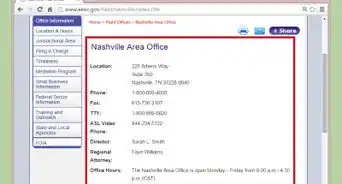This article was written by Jennifer Mueller, JD. Jennifer Mueller is an in-house legal expert at wikiHow. Jennifer reviews, fact-checks, and evaluates wikiHow's legal content to ensure thoroughness and accuracy. She received her JD from Indiana University Maurer School of Law in 2006.
This article has been viewed 33,622 times.
If you are a federal contractor, regulations may require you to have an affirmative action plan in place.[1] Many state governments require this for state contractors as well. The purpose of an affirmative action plan is to correct the effects of past discrimination against people on the basis of their race or gender and provide equal employment opportunities for all. The process of creating an affirmative action plan is extremely complex, so you should review several sample plans before beginning. You may want to work with someone who has experience developing affirmative action plans for businesses or organizations similar to yours.[2] [3]
Steps
Conducting Self-Analysis
-
1Gather demographic data. The first part of your affirmative action plan typically includes information regarding the numbers of employees you currently have of different races and genders.[4]
- Federal regulations require you to analyze your workforce and employment practices, although there is no mandatory method of doing this.[5]
- You may want to review sample affirmative action plans, or approved affirmative action plans in place for organizations similar to yours, to determine the best ways to collect and analyze the necessary data.
- For example, the Department of Labor has some sample affirmative action plans available for download at http://www.dol.gov/ofccp/regs/compliance/aaps/aaps.htm.
-
2Analyze the diversity of your current staff. After you've collected the data, compare it to regulatory standards or industry averages.[6]
- The first part of your written affirmative action plan typically will include tables or charts that show the number of employees in each department, their wage rate, and the number of male and female employees of each race.
- Your self-analysis section should include the percentage of women and racial minorities in each department and wage group.
- Keep in mind that the goal of any affirmative action plan is to achieve the diverse workforce you would have if discrimination had never existed.[7]
- You must place your employees into specific job groups, and compare the proportion of minorities and women in your organization to the proportion of people available to work in that job group within a reasonable recruitment area.[8] [9]
- Your affirmative action plan should include tables that indicate the percentage of women and minorities available compared to the percentage of women and minorities in your organization.
Advertisement -
3Evaluate employment practices and any past programs. Part of the objective of your self-analysis is to determine whether you have any practices or policies in place that have the effect of excluding people who have historically been discriminated against.[10]
- If you've had affirmative action plans in the past, take a look at the diversity in your organization before and after the plan went into effect.[11]
- Look at your job descriptions as well as your hiring and recruitment practices to see if they have the effect of excluding women or racial minorities.[12]
Setting Priorities
-
1Determine which problems are the most severe. To the extent economically feasible, your plan should address the most serious problems first.[13]
- For example, suppose women make up approximately 40 percent of the available labor pool for a particular position in your organization, but your organization doesn't employ a single woman with that job title. That indicates a serious problem that should figure high on your priority list.
- Looking at the tables you created for your self-analysis, you can determine how close your percentages are to the percentage of women or minorities available. Your aim should be for the ratio of your percentage to the availability percentage to be at least 80 percent.
-
2Examine your budget. You must have a good idea of the resources you have available to remedy problems before you can decide what your top priorities will be.[14]
- Some policies may require significant work, taking up substantial resources. When you look at your budget, you want to balance the expense of resolving a problem against the severity of the problem you identified.
- Part of examining your budget includes projecting the possibility of job vacancies, and whether projects will be added or expanded to create new positions.
-
3Evaluate possible solutions. Once you understand your budgetary restrictions, you can eliminate strategies that would be too complex or expensive to include in the final plan.[15]
- To return to the example of the position for which your organization employs no women, possible solutions to that problem would include recruiting women into that position, or providing training and education for women in your organization who have the potential to perform that particular job.
- Look not only at what will need to be done to implement a possible solution, but who will be responsible for carrying out specific acts and what would be expected of them under your plan.
- These expectations should be listed specifically in your plan when you establish roles and designate responsibility for each strategy.
Developing Strategies
-
1Meet with managers and supervisors. While creating your affirmative action plan, you will need to consult several times with the people who will ultimately be in charge of implementing it.[16]
- People who work with hiring and recruiting new employees often have the most knowledge of strategies to attract women, minorities, and other groups into your workforce.
- It is essential to the ultimate effectiveness of your plan that managers in charge of implementing specific policies both understand those policies and feel they played a part in developing the plan.
- Managers and supervisors also should have a good understanding of what is expected of them under the plan, and how they can assist your organization in achieving the plan's goals.
-
2Choose effective policies. Based on input from employees and an analysis of your organization's needs and resources, you should be able to predict which policies have the greatest chance for success.[17]
- For example, one policy approved for affirmative action plans under federal regulations is the creation of a recruitment program designed to attract qualified minorities or women for particular positions within your organization.[18]
- You also may decide to redesign job descriptions to redistribute work so that positions require lesser knowledge or skills than they previously did to attract members of groups that historically did not have access to training.
- While you must solve the problems identified in your self-analysis, your policies should be narrowly tailored to avoid unnecessary restrictions on opportunities for your employees as a whole.
-
3Set benchmarks. Once you've written the overarching policy description, you should set specific, measurable goals that can be reached over time.[19]
- More than discussing lofty goals and ideals, your plan should include specific steps that can be taken to remedy the effects of past discrimination in your workplace.
- Include both long-term and short-range goals, with timetables for meeting these goals.[20]
- Goals should be specific to job classifications and wage groups, taking into account the current and projected job market for those positions.
- Keep in mind that your ultimate goal is to resolve the problems to the point that an affirmative action plan is no longer needed.
-
4Designate key employees. Your plan should include the names or roles of each person who will evaluate and oversee the implementation of your plan.[21]
- Federal regulations require your plan to designate individuals who will have responsibility for implementing each of the specific actions you've described in your plan.
- You may consider designating someone within your human resources department as an Equal Employment Opportunity Manager. You can include this person's job description in your affirmative action plan.
Taking Action
-
1Produce a final written report. Your affirmative action plan will include a detailed statistical analysis of the demographics of your workforce, a description of your goals, and a list of steps to take toward each benchmark.[22]
- Federal regulations require your affirmative action plan to be in writing and dated.
- In addition to submitting your report to the government, you also should make it available to all managers, supervisors, and other employees who will be involved with implementing any part of the plan.
-
2Submit your plan for certification. The federal government or your state government may require you to have your plan approved before your government contract is finalized.
- Generally, you must send a copy of your written plan to the agency in charge of your contract. The plan will be reviewed by a government employee.
- If your plan is approved, you'll receive a certificate indicating the plan is in compliance with state or federal regulations.
-
3Evaluate progress on a regular basis. Include a procedure in your plan for measuring the effectiveness of the plan and the goals you've met.[23]
- Federal regulations require that you establish a system for monitoring the effects of your affirmative action program and making adjustments where necessary to achieve your desired goals.[24]
- You are responsible for conducting regular audits of the program and maintaining documentation that demonstrates your continued compliance with federal regulations.[25]
- You may be responsible for submitting an annual compliance report to the state or federal government that analyzes your organization's performance under the affirmative action plan and your progress towards the plan's goals.
References
- ↑ https://www.law.cornell.edu/cfr/text/41/60-2.1
- ↑ http://www.dol.gov/ofccp/regs/compliance/aaps/aaps.htm
- ↑ https://admin.ks.gov/docs/default-source/ops/affirmative-action-plans/planning.pdf?sfvrsn=2
- ↑ https://admin.ks.gov/docs/default-source/ops/affirmative-action-plans/planning.pdf?sfvrsn=2
- ↑ https://www.law.cornell.edu/cfr/text/29/1608.4
- ↑ https://admin.ks.gov/docs/default-source/ops/affirmative-action-plans/planning.pdf?sfvrsn=2
- ↑ https://www.law.cornell.edu/cfr/text/41/60-2.10
- ↑ https://www.law.cornell.edu/cfr/text/41/60-2.10
- ↑ https://www.law.cornell.edu/cfr/text/41/60-2.14
- ↑ https://www.law.cornell.edu/cfr/text/29/1608.4
- ↑ https://admin.ks.gov/docs/default-source/ops/affirmative-action-plans/planning.pdf?sfvrsn=2
- ↑ https://www.law.cornell.edu/cfr/text/29/1608.4
- ↑ https://admin.ks.gov/docs/default-source/ops/affirmative-action-plans/planning.pdf?sfvrsn=2
- ↑ https://admin.ks.gov/docs/default-source/ops/affirmative-action-plans/planning.pdf?sfvrsn=2
- ↑ https://admin.ks.gov/docs/default-source/ops/affirmative-action-plans/planning.pdf?sfvrsn=2
- ↑ https://admin.ks.gov/docs/default-source/ops/affirmative-action-plans/planning.pdf?sfvrsn=2
- ↑ https://admin.ks.gov/docs/default-source/ops/affirmative-action-plans/planning.pdf?sfvrsn=2
- ↑ https://www.law.cornell.edu/cfr/text/29/1608.4
- ↑ https://admin.ks.gov/docs/default-source/ops/affirmative-action-plans/planning.pdf?sfvrsn=2
- ↑ https://www.law.cornell.edu/cfr/text/29/1608.4
- ↑ https://www.law.cornell.edu/cfr/text/41/60-2.10
- ↑ https://www.law.cornell.edu/cfr/text/29/1608.4
- ↑ https://admin.ks.gov/docs/default-source/ops/affirmative-action-plans/planning.pdf?sfvrsn=2
- ↑ https://www.law.cornell.edu/cfr/text/29/1608.4
- ↑ https://www.law.cornell.edu/cfr/text/41/60-2.10













-Step-24.webp)















-Step-24.webp)





































